Ringing Saturn
The Cassini spacecraft has arrived at Saturn to start exploring the planet and its rings and moons.
By Emily Sohn
Forget Mars. Forget the moon. These days, Saturn is where it’s at.
On June 30, the first space mission focused just on Saturn plunged through the giant planet’s rings. For the next 4 years, if all goes as planned, a spacecraft called Cassini will orbit Saturn, sending loads of information back to Earth about the planet’s atmosphere, its moons, and its rings.
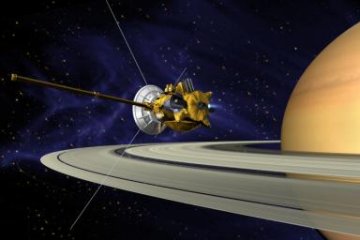 |
|
Artist’s impression of the Cassini spacecraft approaching Saturn’s delicate rings of dust and rocks.
|
| NASA/JPL |
But wait, there’s more. In December, Cassini will release a probe called Huygens that will plummet to the surface of Saturn’s biggest moon, Titan. There, astronomers hope to gain insights into the chemistry and origins of life on Earth.
“The next 6 months should . . . be very exciting,” says Jonathan Lunine. He’s a planetary scientist at the University of Arizona, Tucson. Lunine has been working on the mission for more than 20 years. “Our expectation is that the unexpected will happen,” he says.
Sixth planet
Saturn is the sixth planet from the sun, farther away than Jupiter but closer than Uranus, Neptune, and Pluto. You might recognize it for its spectacular set of rings, but Saturn has plenty of other cool features.
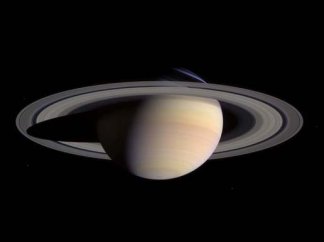 |
|
This portrait of Saturn and its rings was put together from a pair of images taken by cameras aboard the Cassini spacecraft when it was 17.6 million miles from Saturn.
|
| NASA/JPL/Space Science Institute |
For one thing, it’s just a big ball of gas, so there would be nothing to stand on, even if you could get there. The planet is so low in density that it would actually float in water if you could find a bathtub big enough for it. And it has at least 31 moons.
Most of what we already know about Saturn comes from remote observations and brief fly-bys. In 1980 and 1981, the Voyager 1 and Voyager 2 spacecraft took pictures of Saturn as they passed by on their way to the outer planets. That’s when scientists discovered how exciting Titan is.
Titan’s atmosphere
Titan is small compared to Saturn, but it’s bigger than our moon, and it’s bigger than the planet Mercury. Amazingly, it also happens to be the only moon in our solar system that has its own atmosphere. Scientists such as Lunine can’t wait to get a closer look.
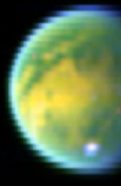 |
|
Cassini’s cameras have captured dramatic views of Saturn’s moon Titan, revealing complex surface markings.
|
| NASA/JPL/Space Science Institute |
That’s because Titan’s thick atmosphere has some of the same gases that we have here on Earth, including nitrogen, carbon dioxide, and lots of methane. Methane is the simplest carbon-containing molecule, made up of one atom of carbon and four atoms of hydrogen. On Earth, it’s produced by the decay of plants and animals.
Learning more about Titan might lead to insights about how life formed on Earth, Lunine says. Long before anything lived here, our planet was a biochemical soup of water and basic elements. Out of this primeval stew, somehow cells and life developed.
Titan has plenty of water, too, though it’s all frozen. The moon is a frigid –178 degrees Celsius at its surface.
Because of volcanic activity or meteor impacts, however, chunks of ice might melt briefly in some places, Lunine says. In such cases, the conditions on Titan could resemble those on Earth billions of years ago.
Lunine doesn’t expect to find traces of life on Titan. But the building blocks of life might be there. He wouldn’t be surprised to find amino acids, for instance, which make up proteins.
“Titan is our only natural laboratory for studying how you go from this real mish-mash of organic chemistry to this very specific situation called life,” Lunine says.
Long mission
Lunine has been looking forward to the Cassini mission for a long time. Astronomers first considered the idea of sending a spacecraft to Saturn in the early 1980s, and Lunine became involved soon after. Scientific planning began in earnest in 1990, and the mission was launched in 1997.
Lunine was there to see the dramatic launch, early on the morning of Oct. 15. “There happened to be a cumulous cloud on the launch pad,” he says. “When the rocket passed through, it looked like hundreds of people turning flashlights on and off.”
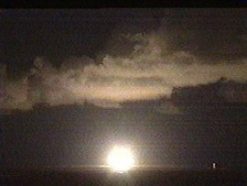 |
|
A video camera captured the launch of the Cassini spacecraft aboard a Titan IVB/Centaur rocket on Oct. 15, 1997.
|
| NASA/JPL |
Just a few days after the launch, researchers in Tucson could see Cassini-Huygens through their telescopes. It looked like a tiny dot moving through the sky.
In reality, the Cassini spacecraft is about the size of a small school bus, with a big antenna. It weighs 1,400 pounds and carries 12 instruments. The Huygens probe is roughly spherical and has a diameter of about 6 feet. By itself, it weighs about 700 pounds and carries six instruments.
Instruments include various cameras, which pick up different kinds of light, and equipment called mass spectrometers and gas chromatographs. Some instruments will work alone. Others will work together. All are essential for uncovering details about the atmosphere and surface of both Titan and Saturn.
The mission will also zero in on Saturn’s rings, its icy moons, magnetic fields, and charged particles that lurk around the planet.
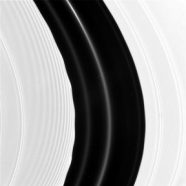 |
|
A close-up of a gap within one of Saturn’s rings shows curious ripples and other delicate features.
|
| NASA/JPL/Space Science Institute |
Planning, designing, and programming the Cassini-Huygens mission has required more than 2 decades of dedicated work by hundreds of astronomers and engineers in both the United States and Europe. Some experts focus on a single instrument. Others, such Lunine, are known as interdisciplinary scientists.
“We’re kind of like the glue,” Lunine says. “We take many different sets of data from different instruments and put a picture together in one scientific area.”
By the time the mission is over, thousands of scientists and students will be involved, digging through the data and trying to interpret what they find.
Risky doings
The basic plan for the mission, now that the spacecraft has arrived at Saturn, is pretty much set. During its 4-year sojourn, Cassini will orbit Saturn 75 times. It will pass near Titan 45 times, and it will use the moon’s gravity to propel itself into different orbits without wasting fuel.
That is, if nothing goes wrong. Despite all the planning, every space mission comes with risks. Cassini had to travel a billion miles just to get to Saturn. Some of its orbits will pass through Saturn’s rings, where dust and big chunks of rock can be a danger. It takes an hour and a half for radio signals to reach the craft from Earth, which means the spacecraft’s computer system needs to be able to respond on its own to unexpected events.
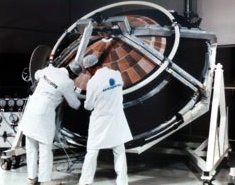 |
|
Technicians working on the Huygens probe before its launch together with the Cassini spacecraft.
|
| European Space Agency |
The Huygens probe faces challenges, too. It’s scheduled to detach itself from Cassini on Dec. 24 and reach Titan on Jan. 15, 2005. Once there, it will cruise through the moon’s atmosphere, taking pictures and collecting other kinds of information. Then, it will crash into Titan’s surface at a speed of 10 to 15 miles per hour. If Huygens survives the landing, it will only have between 5 and 30 minutes to explore before Cassini moves out of range or the probe’s lithium batteries run out. In total, the probe’s mission will last about 3 hours.
After the long, long wait, scientists involved with Cassini-Huygens are holding their breath, hoping everything works out. “I’m trying to let my fingernails grow,” Lunine says, “so I can chew them down again.”
Uncertainty is the name of the game when it comes to deep-space missions. The Mars Polar Lander, for instance, crashed in 1999. Right now, though, two rovers on Mars have far surpassed their expected lifetimes and have sent back an extraordinary wealth of information about the Red Planet.
“Planetary exploration has big highs and big lows,” Lunine says. It’s worth the risk, he adds, because there’s so much left to learn about the universe.
“In the end,” he says, “you just have to keep your fingers crossed.”
Going Deeper:
Saturn Facts:
- Average distance from sun: 887 million miles, or 1.43 billion kilometers.
- Time to orbit the sun: 29 years and 174 days.
- Time it takes to rotate on its axis: 10.5 hours.
- Diameter: 74,897 miles or 120,584 kilometers.
- Surface temperature: –301° Fahrenheit, or –185° Celsius.







